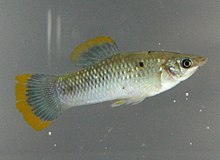| Revision as of 10:41, 1 September 2024 editSurtsicna (talk | contribs)Autopatrolled, Extended confirmed users130,770 edits This is rather misleading as many if not all of these are hybrids and not just Poecilia sphenops. It needs to be rewritten with clarity - and sources.← Previous edit | Revision as of 10:43, 1 September 2024 edit undoSurtsicna (talk | contribs)Autopatrolled, Extended confirmed users130,770 editsNo edit summaryNext edit → | ||
| Line 32: | Line 32: | ||
| }} | }} | ||
| '''''Poecilia sphenops''''' |
'''''Poecilia sphenops''''', called the '''short-finned molly''' or '''common molly''', is a ] fish inhabiting freshwater streams, coastal brackish, and marine waters from ] to ]. The wild-type fishes are dull, silvery in color. The molly can produce fertile hybrids with many '']'' species, most importantly the ]. The male mollies generally tend to be mildly aggressive. | ||
| Mollies rank as one of the most popular ] due to high growth rate, birth size, reproduction, and brood number. | Mollies rank as one of the most popular ] due to high growth rate, birth size, reproduction, and brood number. | ||
Revision as of 10:43, 1 September 2024
Species of livebearer fish
| Molly | |
|---|---|

| |
| Male molly | |
| Conservation status | |
 Least Concern (IUCN 3.1) | |
| Scientific classification | |
| Domain: | Eukaryota |
| Kingdom: | Animalia |
| Phylum: | Chordata |
| Class: | Actinopterygii |
| Order: | Cyprinodontiformes |
| Family: | Poeciliidae |
| Genus: | Poecilia |
| Species: | P. sphenops |
| Binomial name | |
| Poecilia sphenops (Valenciennes, 1846) | |
| Synonyms | |
| |
Poecilia sphenops, called the short-finned molly or common molly, is a poeciliid fish inhabiting freshwater streams, coastal brackish, and marine waters from Mexico to Colombia. The wild-type fishes are dull, silvery in color. The molly can produce fertile hybrids with many Poecilia species, most importantly the sailfin molly. The male mollies generally tend to be mildly aggressive.
Mollies rank as one of the most popular feeder fish due to high growth rate, birth size, reproduction, and brood number.
Biology
Mollies are similar in appearance to their livebearer cousins, the platy, swordtail and guppies; the molly tends to be slightly larger and more energetic. Many aquarists note the stronger individuality and aggression in keeping mollies versus platies, who appear much more docile.
Size
Standard size of male fish is 3.2″ (8 cm) and female fish is 4.8″ (12 cm).
Gallery
References
- Matamoros, W.A. (2019). "Poecilia sphenops". IUCN Red List of Threatened Species. 2019: e.T191753A2002434. doi:10.2305/IUCN.UK.2019-2.RLTS.T191753A2002434.en. Retrieved 19 November 2021.
- Froese, Rainer; Pauly, Daniel (eds.). "Poeclia sphenops". FishBase. August 2019 version.
- "Poecilia sphenops". Integrated Taxonomic Information System. Retrieved 30 January 2006.
- Froese, Rainer; Pauly, Daniel (eds.). "Poecilia sphenops". FishBase. October 2005 version.
- "Mollies Fish" Detailed information on raising the Molly fish. January 2022 version
| Taxon identifiers | |
|---|---|
| Poecilia sphenops | |
This Cyprinodontiformes article is a stub. You can help Misplaced Pages by expanding it. |


